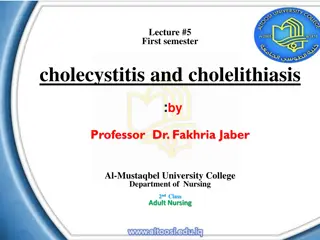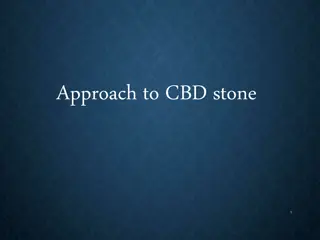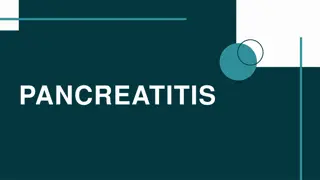
Comprehensive Guide to Gallstones: Types, Symptoms, and Prevention
Explore the world of gallstones, from their definitions to types like pigment, cholesterol, and mixed stones. Discover risk factors, symptoms, complications, diagnosis methods, and prevention strategies. Learn about the importance of early detection and management to avoid serious health issues associated with gallstones.
Download Presentation

Please find below an Image/Link to download the presentation.
The content on the website is provided AS IS for your information and personal use only. It may not be sold, licensed, or shared on other websites without obtaining consent from the author. If you encounter any issues during the download, it is possible that the publisher has removed the file from their server.
You are allowed to download the files provided on this website for personal or commercial use, subject to the condition that they are used lawfully. All files are the property of their respective owners.
The content on the website is provided AS IS for your information and personal use only. It may not be sold, licensed, or shared on other websites without obtaining consent from the author.
E N D
Presentation Transcript
StudyMafia.Org Gallstones Submitted To: Studymafia.org Studymafia.org Submitted By:
Table Contents Definition Introduction Types of Gallstones Risk Factors Symptoms of Gallstones Complications of Gallstones Diagnosis of Gallstones Prevention of Gallstones Conclusion
Definitions Acute GB inflammation due to cystic duct obstruction. Persistent RUQ pain +/- fever, WBC, LFT, +Murphy s = inspiratory arrest Acute cholecystitis Recurrent bouts of colic/acute chol y leading to chronic GB wall inflamm/fibrosis. No fever/WBC. Chronic cholecystitis GB inflammation due to biliary stasis(5% of time) and not stones(95%). Seen in critically ill pts Acalculous cholecystitis Gallstone in the common bile duct (primary means originated there, secondary = from GB) Choledocho- lithiasis Infection within bile ducts usu due to obstrux of CBD. Charcot triad: RUQ pain, jaundice, fever (seen in 70% of pts), can lead to septic shock Cholangitis
Introduction Small, pebble-like substances Multiple or solitary May occur anywhere within the biliary tree Have different appearance - depending on their contents
Types of Gallstones Pigment Stones Small Friable Irregular Dark Made of bilirubin and calcium salts Less than 20% of cholesterol Risk factors: Haemolysis Liver cirrhosis Biliary tract infections Ileal resection
Types of Gallstones Cholesterol Stones Large Often solitary Yellow, white or green Made primarily of cholesterol (>70%) Risk factors: 4 F : Female Forty Fertile Fat Fair (5th F more prevalent in Caucasians) Family history (6th F )
Types of Gallstones Mixed Stones Multiple Faceted Consist of: Calcium salts Pigment Cholesterol (30% - 70%) 80% - associated with chronic cholecystitis
Risk Factors Women Age > 60 years American Indians & Mexican Americans Overweight or obese men and women People who tend to fast or lose weight quickly Family history of gallstones Diabetes Diet high in cholesterol Use of OCPs Pregnancy
Symptoms of Gallstones Pain in the RUQ Most common and typical symptom May last for a few minutes to several hours Mostly felt after eating a heavy and high-fat meal Pain under right shoulder when lifting up arms Fever, nausea and vomiting Jaundice (obstruction of the bile duct passage) Acute pancreatitis (gallstone enters the duct leading to pancreas and blocks it)
Complications Of Gallstones In the GB: Biliary colic Acute and chronic cholecystitis Empyema Mucocoele Carcinoma In the bile ducts: Obstructive jaundice Pancreatitis Cholangitis In the gut: Gallstone ileus
Diagnosis of Gallstones Ultrasound Computerized tomography (CT) scan May show gallstones or complications, such as infection and rupture of GB or bile ducts Cholescintigraphy (HIDA scan) Used to diagnose abnormal contraction of gallbladder or obstruction of bile ducts Endoscopic retrograde cholangiopancreatography (ERCP) Used to locate and remove stones in bile ducts Blood tests Performed to look for signs of infection, obstruction, pancreatitis, or jaundice
USG CT Scan
Diagnosis of Gallstones Surgical options Cholecystostomy Subtotal cholecystectomy Open cholecystectomy Laparoscopic cholecystectomy
Prevention of Gallstones A sensible diet is the best way to prevent gall stones Avoid crash diet or very low intake of calories Eat good sources of fiber
Conclusion Patients with cholelithiasis are at a higher risk of developing depression than the general population regardless of age, sex, and presence of comorbidities. Patients who underwent cholecystectomy could have a reduced risk of depression.
References Google.com Wikipedia.org Studymafia.org Slidespanda.com
Thanks To StudyMafia.org






















